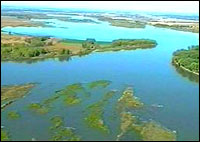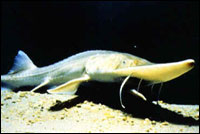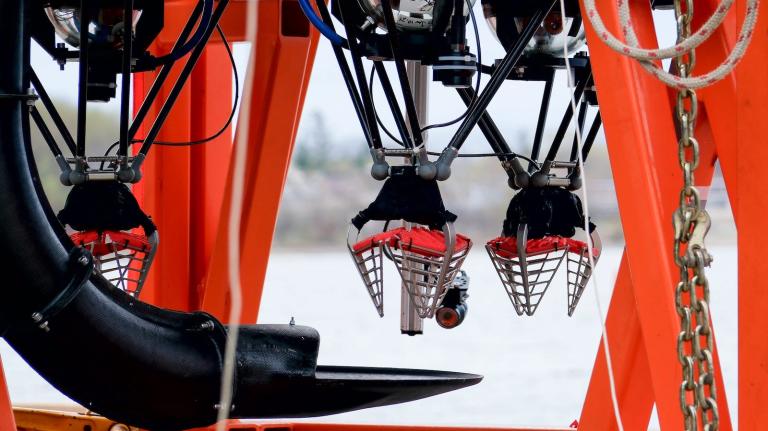Basically, the Army Corps has flipped us the bird — at a time when it’s supposed to be saving the birds.”

Hello, Big Muddy.
Photo: FWS.
That’s how Eric Eckl, spokesperson for American Rivers, sums up the Army Corps of Engineers‘ new plan to manage the Missouri River, released on Friday to blistering protest and threats of a new round of lawsuits from the environmental community.
The plan disregards more than a decade of calls to restore the natural flows of the beloved “Big Muddy” — calls from scientists at the U.S. Fish and Wildlife Service and the National Academy of Sciences, and from a federal court last year that demanded the Corps change river flows to comply with the Endangered Species Act.
Since about 1990, scientists have identified an increasingly pressing need to recreate more natural spring and summer flows in the Missouri — whose waters are controlled by six enormous hydroelectric dams — to prevent extinction of the river’s endangered and threatened populations of sturgeon, tern, and plover and guard against future flooding. Just this past December, scientists from the FWS confirmed once again the need to alter flows, even after the research team was replaced at the 11th hour with new scientists at the Corps’ behest.
The environmental community was generally pleased with the new team’s results, but according to Chad Smith, director of the Nebraska field office for American Rivers, “In retrospect, it’s become clear that the new team amended a 300-page report in such a hurry that they created loopholes which the Corps has been able to exploit.”
Smith argues that the loopholes allow the Corps to manufacture 1,200 acres of artificial habitat for imperiled species rather than take the more effective and less costly route of restoring the river’s natural flows. And the Corps plans to do it in a mere four months, by July 1, rather than in the several-year time frame that FWS scientists predicted it would take.
“This would not only be an extraordinarily irresponsible rush job,” said Smith. “It’s impossible. It simply can’t be done.”
But Craig Manson, assistant secretary of the interior for fish, wildlife, and parks, says his agency supports the Corps’ interpretation of the scientific results. “This is not a loophole, it’s written in black and white,” says Manson. “The biological opinion says that if the Corps can create the new habitat, they can operate at higher flows. Only the Corps knows if they can recreate the habitat effectively in that time frame; and if they can, that’s just fine.”

Tom Daschle.
Photo: U.S. Senate.
Beltway politicians have also jumped into the fray. Senate Minority Leader Tom Daschle (D-S.D.), whose state straddles a northern section of the Missouri and would benefit from increased recreation as a result of healthier fish and bird populations and higher water levels in reservoirs, criticized the plan in a statement on Friday: “I am disappointed that the best the Corps can come up with is a document that provides little more than the status quo [and] blatantly ignores sound science.”
On the other side of the boxing ring is Sen. Kit Bond (R-Mo.), who objects vehemently to river-flow changes, arguing that they would cripple the barge industry in his state as well as the farmers who ship their cargo up and down the river. Bond is so vocal about the issue that when President Bush attended a fundraiser for the senator this past summer, he appeased Bond with a declaration that no federal agency should govern the flow of the longest river in America.
Less than a week before the Corps came out with its revised plan, Bond was sounding his battle cry against river-flow changes. “Unless clarified, the Department of Interior’s 2003 Missouri River biological opinion will cause extreme harm to farmers, transporters, electrical consumers, and municipalities on the lower Missouri and Mississippi rivers,” Bond said at a meeting with industry representatives on Feb. 21.

Endangered Missouri River sturgeon could be up a creek.
Photo: FWS.
After the plan was unveiled, Bond’s office issued a press release that evoked Bush’s commitment, saying the senator has “talked to the president and high-level administration officials on a number of occasions, and will continue to push the administration to make good on its promise.”
But environmental groups are also ready to rumble. “We’ve been fighting this fight for years, with the support of local communities, federal courts, and the soundest science. You can be sure we aren’t going to stop now,” says Eckl, whose organization is in the midst of a lawsuit against the Corps and intends to integrate these new developments into the case. “The scientific evidence is so overwhelmingly stacked against this plan that there’s simply no way a federal court can condone it.”
Enviros are up against a formidable foe, given that Bush himself has a vested interest in Missouri, a swing state with more electoral votes than any of the six other states that share the river. But the president has been conspicuously quiet on the issue lately, having said nothing about it in his recent campaign visits to the state, despite election-year pressure to keep his Missouri constituency happy. Perhaps he realizes that this issue is a political lightning rod — if he grabs hold of it, environmentalists may use it to fry him in other Missouri River basin states this election season.
The Corps will accept public comments on its Missouri River management plan between March 5 and March 19.


